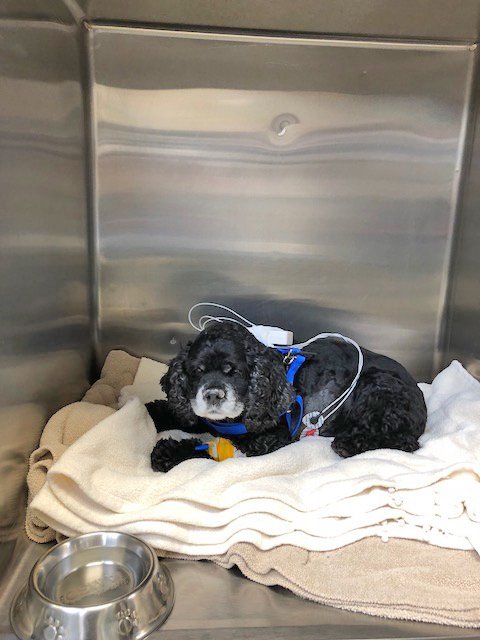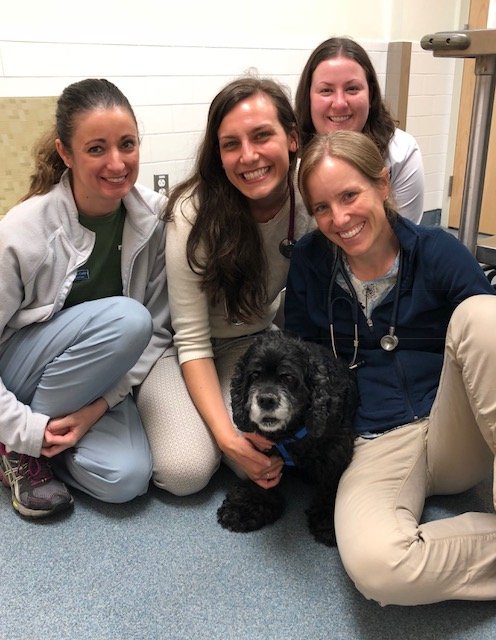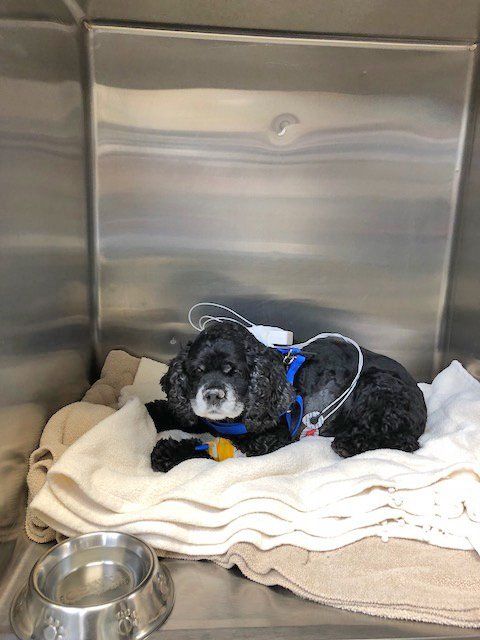

2″He might not live through the night” wasn’t what Susan and Marty Gavin were expecting to hear. Yes, their 13-year-old cocker spaniel, Henry, had fallen over when he came up the stairs earlier that evening. But “we thought the emergency room vet would say ‘epilepsy’ or some sort of brain seizure,” Henry’s “dad,” Dr. Gavin, says. “He fell on his side and was moving his limbs.”
Henry also fell over as the Gavins were getting him to the car and then again inside the doctor’s office.
But these episodes weren’t seizures. They were fainting spells resulting from a dangerously slow and erratic heart rhythm. After conducting an electrocardiogram (EKG) on Henry, the veterinarian said, “you can euthanize him tonight or get him up to Tufts for a pacemaker.”
“He showed us the EKG printout,” Dr. Gavin remarks. “There was no discernible pattern. It looked like a Geiger counter.”
It was already 10 pm, and the Gavins asked if they could wait till morning. “You don’t have any options here,” the doctor said. So they raced home, packed, and headed up to Tufts, which was two hours away from their residence in southern Connecticut. On the way, Henry emptied his bladder all over Mrs. Gavin. She remembers thinking, “Oh my God, is this it? Are his organs shutting down?”
What happened to Henry is not always the scenario for dogs with slow heart rates who need a pacemaker, says the chief of cardiology at Tufts Foster Hospital for Small Animals, John Rush, DVM. In dogs with certain forms of slow heart rate, there tends to be some warning. “The dog faints once a month, then seven times over the course of a weekend,” and then the family comes in. But when the fainting episodes come in quick succession, or when fainting is due to something called Third Degree AV Block, as in Henry’s case, the risk for death tends to be greater.
The Gavins’ dog was admitted to the ICU when he arrived at Tufts in the wee hours, where he was stabilized and monitored. Dr. Gavin recalls that “they asked if they should do CPR if he coded [had cardiac arrest], and we said ‘yes.'” Later that day, Henry had his surgery to insert a pacemaker. But his troubles weren’t over.
How a pacemaker works
As you no doubt learned in high school biology, the heart has two atria and two ventricles. When heart muscle contracts, blood flows from the atria to the ventricles, and from there it gets pumped out to all the tissues of the body. But how does the heart muscle know to contract, to have a “beat,” and how does it know how often to beat so the rhythm of the heart is appropriate?
That’s where electricity comes in. An electrical impulse inside the heart is triggered constantly to get your heart to keep contracting, or beating. Electrical pathways in the heart, sort of like wires that connect any electrical circuit/device, send an electrical signal from the atria (the heart’s upper chambers) to the ventricles (the lower chambers). But things can go wrong within the circuit. For instance, a node through which the electrical signal passes — the AV (atrioventricular) node — can become diseased. When that happens, the electrical impulse cannot make its way from the atria to the ventricles, so they don’t fire properly. “The ventricles have a mechanism that causes them to fire really slowly so the dog doesn’t die,” says Dr. Rush, “but it’s slow enough that a dog may keep fainting,” which is what was happening to Henry. “In some cases, it may fail to fire altogether, and a dog will die suddenly.”
Enter a pacemaker, which contains a pulse generator — “the brains of a pacemaker,” Dr. Rush says — and a lead wire threading from there to one of the ventricles. Once a pacemaker is in place, the ventricle no longer needs to rely on the very slow mechanism that kicks in when the heart rate is too slow. “We can set the pacemaker to fire at a pace we think is best for the dog,” Dr. Rush explains — “maybe 70 beats per minute when the animal is at rest as opposed to 30 beats per minute or less.” The pacemaker contains a computer that monitors the heart rate and allows the necessary electrical impulse to occur whenever the heart’s natural rate falls below the minimum rate at which the machine is set.
A pacemaker also has the ability to sense a dog’s activity level, meaning that if it senses the dog is engaging in vigorous physical activity, it can increase the firing rate up to 120 or 140 beats per minute to accommodate the sped-up level of moving about and the extra pumping of blood required.
A compromised AV node is just one potential issue. Another reason a dog might need a pacemaker is a diseased sinus node, or SA node. It is akin to the heart’s light switch, and if it doesn’t work right, there can be long pauses between heart beats — 8, 9, 12, 15 seconds, Dr. Rush notes. “If you get out close to 12 or 15 seconds with no heart beat, no contraction, which means no blood is being pumped to the brain, you’ll have a fainting episode. The risk of sudden death with a sick sinus node is less than for a dog with a diseased AV node, but he might have really bad fainting episodes. That’s a case where an owner might notice his pet fainting infrequently, then several times over the course of just two or three days. We put in a pacemaker to take over for the sick SA node, and the dog never faints again.”
As with a diseased AV node, a pacemaker to correct for a sick sinus node is most commonly placed in a ventricle. But it allows electrical firing to go on in the whole heart. “It’s like a ripple effect,” Dr. Rush says, “like a stadium where they do the wave. It starts somewhere and then keeps going. If you poke one spot with electricity, the cells around that spot will then fire, and then the cells around them, until it washes through the entire ventricle that needs to be told to beat.”


The operation and its aftermath
The surgery to put in a pacemaker takes an hour or two, including time for the anesthesia to take effect and also for the dog to wake up. The lead is passed through the wall of the jugular vein in the neck, then down into the heart, where it engages the heart muscle. In most situations, it is conducted in a fluoroscopy suite, meaning one where there’s a machine that can do a continuous x-ray so the cardiologist can see where the lead is going and make sure it ends up in the right place.
After the operation, owners are advised to keep their dogs very quiet for the first two weeks and then just let them engage in moderate activity for the first month or two. That’s because in the first couple of months after the operation, Dr. Rush says, if a dog is very active, the pacemaker lead wire can dislodge — literally pull away from the heart muscle in which it was placed. And that can cause the heart rate to slow again and cause the dog to go back to having fainting episodes.
“Dislodgment occurs in anywhere from two to 10 percent of dogs,” Dr. Rush comments, “and when it does, we have to go back in surgically and reposition the lead in the ventricle.” If you wait a couple of months before letting the dog return to his usual activity level, on the other hand, scar tissues forms around the lead, making it a lot less likely to be able to leave the spot.
A less common complication is an infection around the pacemaker/pulse generator or the lead wire, occurring in about one to two percent of cases. “You usually can’t get the infection under control with antibiotics,” Dr. Rush says, because it’s hard to take care of killing bacteria that get into the nooks and crannies in and around the implanted device. You have to remove the pacemaker and the lead wire and put in new ones at somewhat different sites.”


Henry’s progress
“Henry made it fine through the surgery,” his “mom,” Mrs. Gavin, says. “We couldn’t see him that day, just in case he got excited. But when we were allowed to go in, he was up and walking. We could see a huge pacemaker bulging through his neck. It was like he had a goiter. (The pulse generator — the bulky part — sits in the neck and you can actually feel it there, while the lead wire goes down into the heart itself.)
“We were able to take him home two days later,” Mrs. Gavin continues. “We followed all the precautionary measures — keeping him quiet, not letting him do stairs. After a few days, we did let him go down a couple of stairs on his own, which the doctor said was okay. He seemed to be doing fine. But exactly six weeks later to the day, which should have been the end of his recovery time, he slid down the stairs. The next day, he was acting odd. He didn’t want to eat, even though he’s definitely food-motivated. The day after that, Marty took his pulse — it was 40 beats per minute. He was very lethargic, just lying down.”
“It was supposed to be about 80 beats per minute,” Dr. Gavin says.
“Adds Mrs. Gavin, “they had told us that if it went lower than 50, it was problematic.”
Back to the emergency room they raced, where the couple was told they had to get Henry back up to Tufts. It turned out his heart was more diseased than diagnostics had initially been able to show, and the problem couldn’t be fixed without a second surgery.
On top of that, Henry was one of the very rare cases where an infection develops. He was very sick for several days.
While Henry was going through his ordeal, the Gavins found a Facebook page called Dogs with Pacemakers. “I’ll tell you,” Dr. Gavin says, “that was so heart-lifting. It showed dogs of all sizes, six months after their surgeries, running at the beach. It really gave us some hope that Henry would be back to normal again.”
“It was a week from hell,” Mrs. Gavin says. “We were back in Connecticut at our jobs, and every day we didn’t know if that was the last we were going to hear of our dog.”
Says Dr. Gavin, his voice catching, “the thought of him dying two hours away was heart-breaking.”
Fortunately, the couple says, the medical staff at Tufts was fantastic about keeping them apprised in real time, with the doctor and others phoning them every day and sending them e-mails with updates. Finally, four days later, Henry was stable and ready for surgery again, and Tufts veterinary technician (read: nurse) Kristen Antoon, one of only 22 vet techs in the country certified as a cardiology specialist, sent the Gavins a video of him eating for the first time since the crisis began. “That made our week,” Mrs. Gavin says.
The next day, Henry had another surgery to replace the first pacemaker with a new one. It was much smaller, “much less noticeable” than the first, Mrs. Gavin says. During the surgery, a blood clot was found on the original lead, so Henry now takes a blood thinner as a precaution.
Clot formation is one of a small handful of complications that can occur with placement of a cardiac pacemaker system, Dr. Rush says. One in five canine patients may end up with that or dislodgment of the lead, failure of the battery, fracture of the lead wire, or infection of the system. But in the large majority of cases, having a pacemaker put into your dog to extend his health and his lifespan is nowhere near as dramatic a scenario as the Gavins experienced. It most often goes swimmingly. “Clients are glad that they opted for pacemaker implantation,” Dr. Rush says. “It gives them back the dog they had only a few weeks earlier.”
The Gavins know this firsthand. Today, Henry is back to his old self, “the same as before the first incident,” Dr. Gavin says — which means, according to Mrs. Gavin, that he is once again “peppy, nosy, stubborn, and lots of fun. We adore him.” (As if we couldn’t tell.)
Rechecks
The typical dog who gets a pacemaker is somewhere between seven and 14 years old, and the battery life is “at a minimum, three years, and, at the outside, sometimes as long as 10 years,” Dr. Rush says. With that in mind, people worry that the battery in the pacemaker will finally give out, and the dog will have to have another surgery to replace the original. It’s a fair enough concern. If you have to replace the battery, it’s an ordeal. That’s because you have to replace the entire pulse generator; there is no easy “switch out for a new battery” option. Replacing it means another surgery that “takes as least as long as the first and costs almost the same amount of money,” Dr. Rush says — “in the $4,000 to $5,000 range. So you would like to not have the battery die.” How can you facilitate that?
With periodic checkups. There’s a wand hooked up to a pacemaker computer that the veterinarian can wave over your dog’s body, and “it senses what’s happening,” Dr. Rush says. “The computer and the pacemaker talk to each other, and the doctor learns how many times the pacemaker was used, how often the dog’s own heart kicked in, how many times the pacemaker went to a faster rate, whether there was abnormal activity on the part of the pacemaker, and also, the battery life. Based on what is found, the doctor can then reprogram the pacemaker, giving it a faster or slower heart rate each time it triggers. If the battery is starting to fail, it may be possible to reduce the voltage that’s transmitted to the heart muscle — it saves battery life, so the pacemaker lasts longer. It’s all about tweaking things to optimize the function of the pacemaker without compromising the function of the heart, creating the most efficient use of the pacemaker possible.”
To stay on the safe side, “we tell people we should see their dog three months after the procedure and every six months after that in order to “interrogate the pacemaker and maybe reprogram it,” Dr. Rush says. “A handful of people don’t do that. They show up four years later and the battery’s dead, and they have to replace it, when if they had been coming all along, they might have been able to prolong battery life.”
Henry is due for his first recheck this month. Considering that he recently got into a scuffle with a feral cat who dared to make its way into his yard, the Gavins aren’t anticipating any problems.






sounds like you didn’t manage your dog properly after the surgery. letting him go up and down stairs. idiots
You’re a jerk. You don’t know anything about it.
Things can happen quickly. They put a pacemaker in a dog. Not everyone would do that.
Thanks for sharing. Can you tell me about what the total cost was for this procedure. We have a Tibetan spaniel that is having the same problem. He has congested heart failure. We love him dearly and I believe my wife would definitely have the done as she loves him like he was her own child.